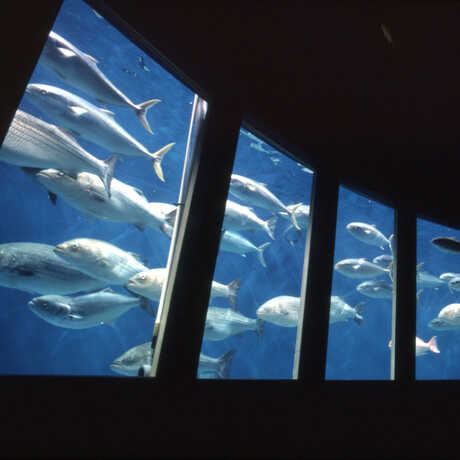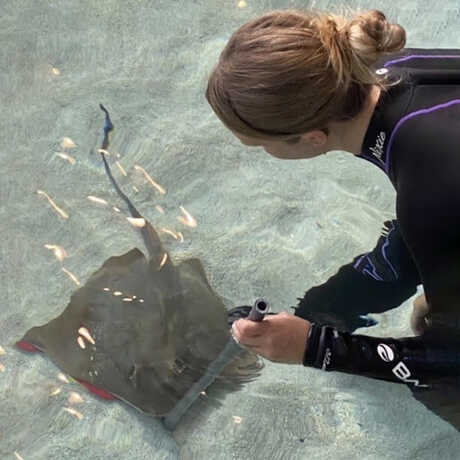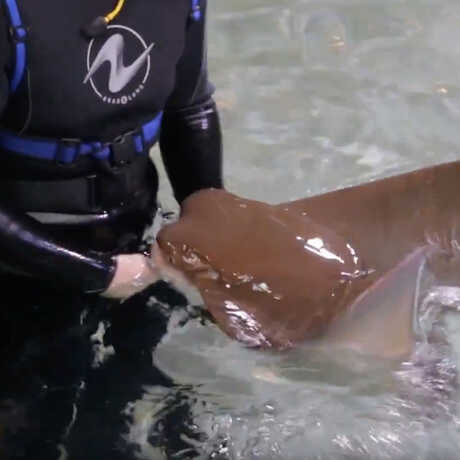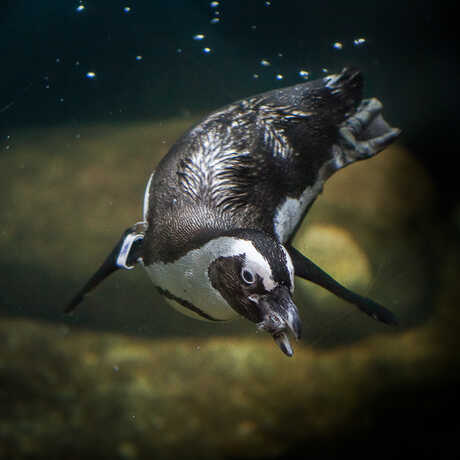Creature Closeups
Methuselah (Our Australian Lungfish)
It's o-fish-ial: Methuselah is the world's oldest aquarium fish! New DNA analysis estimates Methuselah's age to be 93 years old (± 9 years). We're thrilled to confirm this critical part of her life story—and proud to contribute vital data toward conservation efforts for her species.
Where were you in 1938? If you’re under age 85, well…you weren’t. Methuselah, however, had just journeyed from Australia to San Francisco on Matson Shipping Lines, and was beginning her reign as the elder statesfish of Steinhart Aquarium.
While she won’t come anywhere close to her biblical namesake’s fabled age of 969, our beloved Australian lungfish (Neoceratodus forsteri) is officially the oldest living fish in human care. She’s also kind of a time machine: As a member of a genus (Neoceratodus) that has essentially stayed the same for over 100 million years, Methuselah is a “living fossil,” offering a fascinating glimpse into the prehistoric past.
Description
With its overlapping, fan-shaped scales, broad, blunt snout, and torpedo-like body, the Australian lungfish looks like it swam right out of the Paleozoic era. And in a way, it did: Fossil records show its ancient ancestors appearing on the scene 380 million years ago, making Neoceratodus one of the oldest living genera of backboned animals on Earth—and the closest living relative to the first fish that crawled out of the sea.
The clue to N. forsteri’s other main claim to fame lies in its name: It has a lung! The vast majority of fish species don’t have lungs and breathe with their gills, but the Australian lungfish can supplement its oxygen intake by gulping air at the surface. This usually only occurs when water levels are low, water quality is poor, or during periods of unusual activity—like spawning season.
Range, distribution, and habitat
Australian lungfish are native to only a handful of sluggish river systems in southeastern Queensland, Australia. They tend to congregate where they camouflage best with their surroundings, like under logs and among dense aquatic vegetation. Their preference for slow-moving or still waterways also matches their disposition: A mostly sedentary species, Australian lungfish rarely stray from their “home” pools.
Diet
In the wild, Australian lungfish are mostly carnivorous, feasting on fish, frogs, tadpoles, and freshwater invertebrates. At the Academy, we vary Methuselah’s diet regularly to please her refined palate and keep her healthy. Her favorite food? Fresh figs—but only when they’re in season in the fall. Here’s what’s on her rotating menu:
- Fish: 4 capelin or 5 whitebait
- Invertebrates: 4 cut clams or 6 prawns; earthworms
- Vegetables: Romaine lettuce
- Fruit: 6 grapes, 3 halved figs, 5 blackberries
- Dry food: Algae tabs
If you’re visiting on a Sunday or Wednesday afternoon, you might be lucky enough to witness Methuselah’s mealtime.
Behavior and reproduction
Like Methuselah, wild Australian lungfish lead a leisurely lifestyle. Perhaps they’re saving up their energy for spawning season: Between August and November, the fish engage in a frenzy of unusual, complex courtship behaviors. First, male and female fish circle each other close to the water’s surface, breathing air loudly, and seemingly in sync. Then, the male will reinforce his amorous intentions by repeatedly nudging the female. Finally, the female will dive down into submerged vegetation where she laid her eggs, followed closely by the male, who will then fertilize the eggs. After about 30 days, the eggs will hatch—and with any luck, the juvenile lungfish will achieve Methuselah-like levels of longevity.
Conservation
Neoceratodus forsteri’s epic history stretches over 100 million years into the past—but its future could be decided in the coming decades. Listed as Endangered on the IUCN Red List, Australian lungfish are highly sensitive to human-caused changes to its riparian habitat, primarily damming and increased sediment levels. Luckily, its numbers appear to have stabilized, and species ambassadors like Methuselah help remind the public of the fish’s vital role as a critical piece of our evolutionary puzzle.
References and further reading
-
Brooks, S., Espinoza, T., Kennard, M., Arthrington, A., & Roberts, D. (2019). Neoceratodus forsteri (Queensland Lungfish). IUCN Red List. Retrieved February 28, 2022, from https://www.iucnredlist.org/species/122899816/123382021
-
Encyclopedia of Life. (n.d.). Queensland lungfish articles - Encyclopedia of Life. Retrieved February 28, 2022, from https://eol.org/pages/339109/articles
-
Fox, A. (2021, January 27). Australian Lungfish Has Biggest Genome Ever Sequenced. Smithsonian Magazine. https://www.smithsonianmag.com/smart-news/australian-lungfish-has-biggest-genome-ever-sequenced-180976837/
-
Garner, S. (2011). Neoceratodus forsteri. Animal Diversity Web. Retrieved February 28, 2022 from https://animaldiversity.org/accounts/Neoceratodus_forsteri/
-
Hartlaub, P. (2022, January 5). The oldest aquarium fish in the world lives in San Francisco. She likes belly rubs. San Francisco Chronicle. https://www.sfchronicle.com/bayarea/article/The-oldest-aquarium-fish-in-the-world-lives-in-16749810.php
-
McGrouther, M. (2020, December 21). Australian Lungfish. The Australian Museum. Retrieved February 28, 2022, from https://australian.museum/learn/animals/fishes/australian-lungfish-neoceratodus-forsteri-krefft-1870/
-
Neoceratodus forsteri (Queensland Lungfish, Australian Lungfish). (2021, October 3). Australian Government Department of Agriculture, Water and the Environment. Retrieved February 28, 2022, from https://www.awe.gov.au/environment/biodiversity/threatened/conservation-advices/neoceratodus-forsteri
Common name: Australian (or Queensland) lungfish
Scientific name: Neoceratodus forsteri
Size: Up to 4 ½ feet long and 95 lbs. (Methuselah is about 4 feet long and 25 lbs.)
Range: Southeastern Queensland, Australia
Habitat: Deep pools in slow-moving rivers
IUCN Red List status: Endangered
As you step down into the Water Planet exhibit in Steinhart Aquarium, Methuselah’s habitat is to your left, across from the alligator gars.







